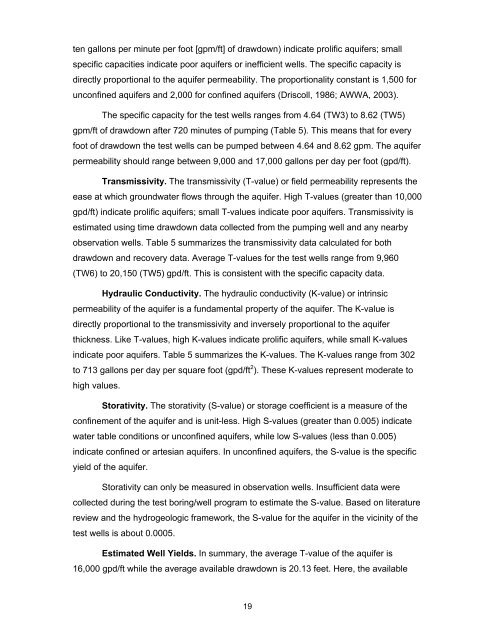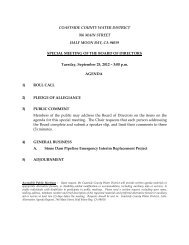Lower Pilarcitos Creek Groundwater Basin Study - Coastside ...
Lower Pilarcitos Creek Groundwater Basin Study - Coastside ...
Lower Pilarcitos Creek Groundwater Basin Study - Coastside ...
Create successful ePaper yourself
Turn your PDF publications into a flip-book with our unique Google optimized e-Paper software.
ten gallons per minute per foot [gpm/ft] of drawdown) indicate prolific aquifers; small<br />
specific capacities indicate poor aquifers or inefficient wells. The specific capacity is<br />
directly proportional to the aquifer permeability. The proportionality constant is 1,500 for<br />
unconfined aquifers and 2,000 for confined aquifers (Driscoll, 1986; AWWA, 2003).<br />
The specific capacity for the test wells ranges from 4.64 (TW3) to 8.62 (TW5)<br />
gpm/ft of drawdown after 720 minutes of pumping (Table 5). This means that for every<br />
foot of drawdown the test wells can be pumped between 4.64 and 8.62 gpm. The aquifer<br />
permeability should range between 9,000 and 17,000 gallons per day per foot (gpd/ft).<br />
Transmissivity. The transmissivity (T-value) or field permeability represents the<br />
ease at which groundwater flows through the aquifer. High T-values (greater than 10,000<br />
gpd/ft) indicate prolific aquifers; small T-values indicate poor aquifers. Transmissivity is<br />
estimated using time drawdown data collected from the pumping well and any nearby<br />
observation wells. Table 5 summarizes the transmissivity data calculated for both<br />
drawdown and recovery data. Average T-values for the test wells range from 9,960<br />
(TW6) to 20,150 (TW5) gpd/ft. This is consistent with the specific capacity data.<br />
Hydraulic Conductivity. The hydraulic conductivity (K-value) or intrinsic<br />
permeability of the aquifer is a fundamental property of the aquifer. The K-value is<br />
directly proportional to the transmissivity and inversely proportional to the aquifer<br />
thickness. Like T-values, high K-values indicate prolific aquifers, while small K-values<br />
indicate poor aquifers. Table 5 summarizes the K-values. The K-values range from 302<br />
to 713 gallons per day per square foot (gpd/ft 2 ). These K-values represent moderate to<br />
high values.<br />
Storativity. The storativity (S-value) or storage coefficient is a measure of the<br />
confinement of the aquifer and is unit-less. High S-values (greater than 0.005) indicate<br />
water table conditions or unconfined aquifers, while low S-values (less than 0.005)<br />
indicate confined or artesian aquifers. In unconfined aquifers, the S-value is the specific<br />
yield of the aquifer.<br />
Storativity can only be measured in observation wells. Insufficient data were<br />
collected during the test boring/well program to estimate the S-value. Based on literature<br />
review and the hydrogeologic framework, the S-value for the aquifer in the vicinity of the<br />
test wells is about 0.0005.<br />
Estimated Well Yields. In summary, the average T-value of the aquifer is<br />
16,000 gpd/ft while the average available drawdown is 20.13 feet. Here, the available<br />
19



